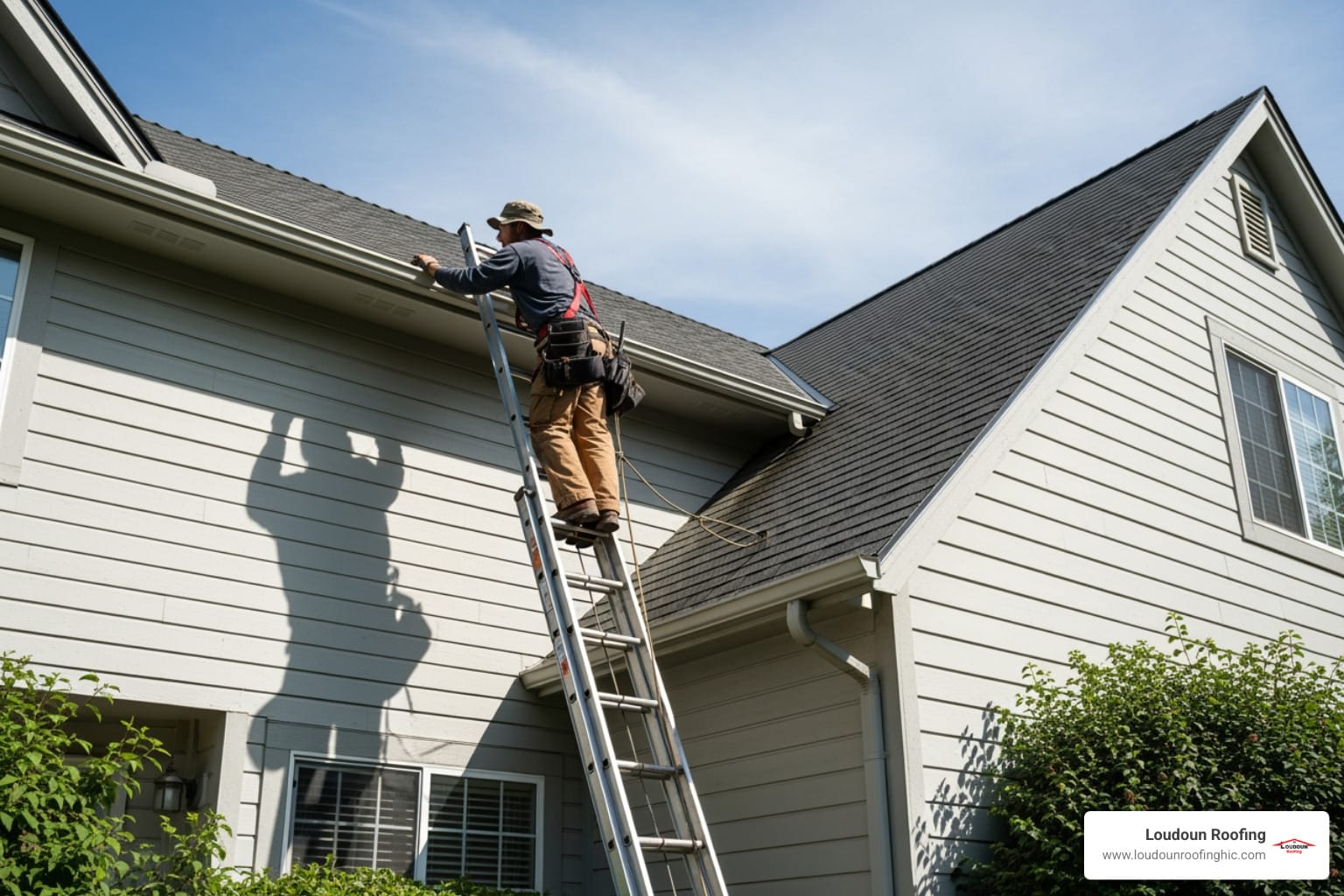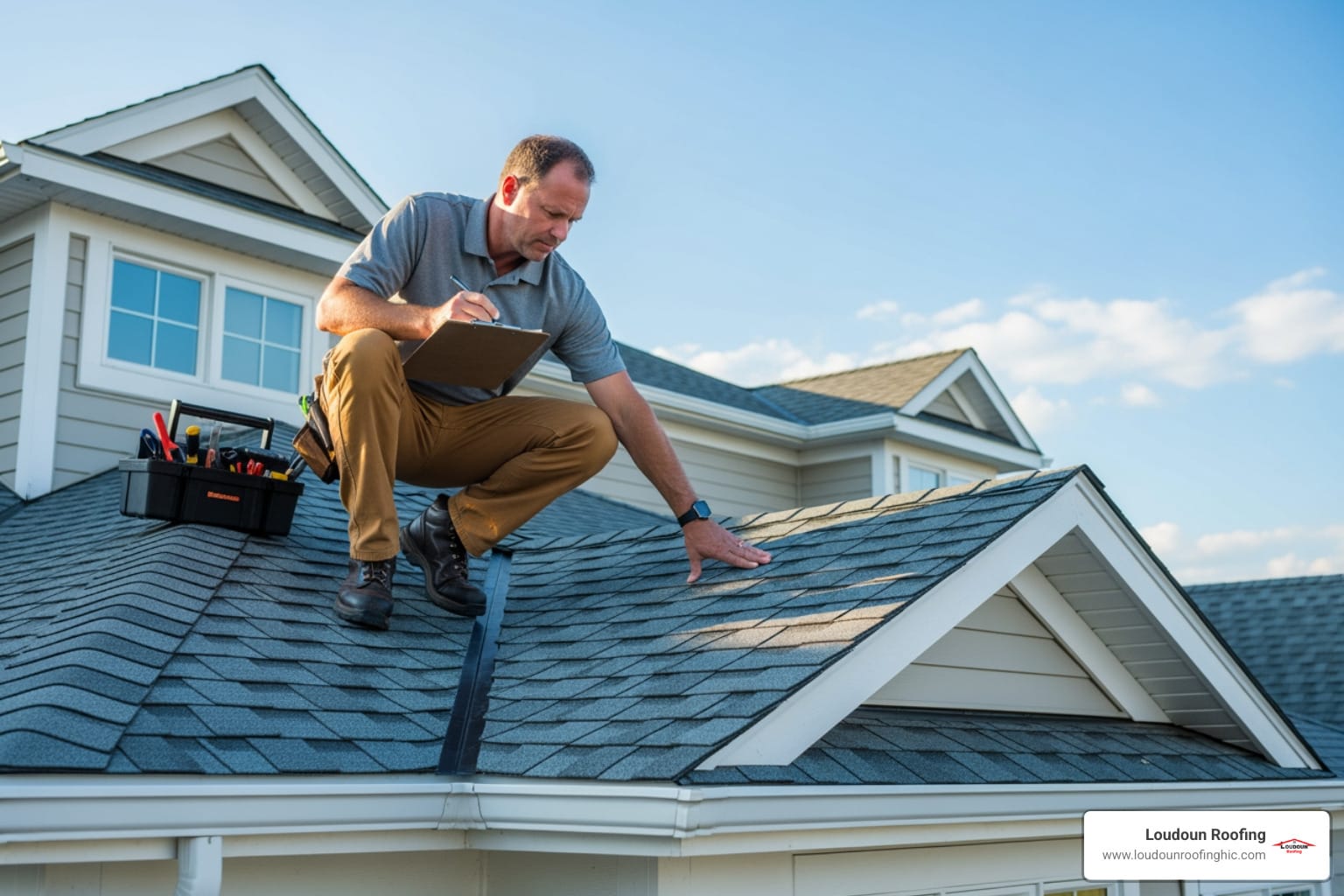Why Getting a Free Roof Estimate is Your First Step to Protecting Your Investment
A free roof estimate is essential when dealing with roof damage, planning a replacement, or building new construction. Here’s how to get yours:
Quick Steps to Get a Free Roof Estimate:
- Contact local contractors – Call or fill out online forms
- Schedule an inspection – Allow 1-2 hours for thorough assessment
- Review the detailed estimate – Look for itemized costs and materials
- Compare multiple quotes – Get 3-4 estimates for best value
Your roof protects everything you value most. Whether you’re dealing with storm damage, an aging roof, or planning new construction, getting an accurate estimate is the foundation of any successful Northern Virginia roofing project.
The difference between a quick online quote and a professional estimate can save you thousands. Online calculators might give you a ballpark figure in seconds, but they can’t detect hidden damage, assess your roof’s unique complexity, or account for local building codes.
This guide walks you through everything you need to know about getting a reliable, hassle-free roof estimate – from understanding what should be included to choosing the right contractor for your Northern Virginia home.
I’m Esteban Marin, owner of Loudoun Roofing & Home Improvement, and I’ve been providing detailed free roof estimates to homeowners across Loudoun County since 2001. My hands-on approach ensures every estimate accurately reflects your roof’s specific needs and local requirements.
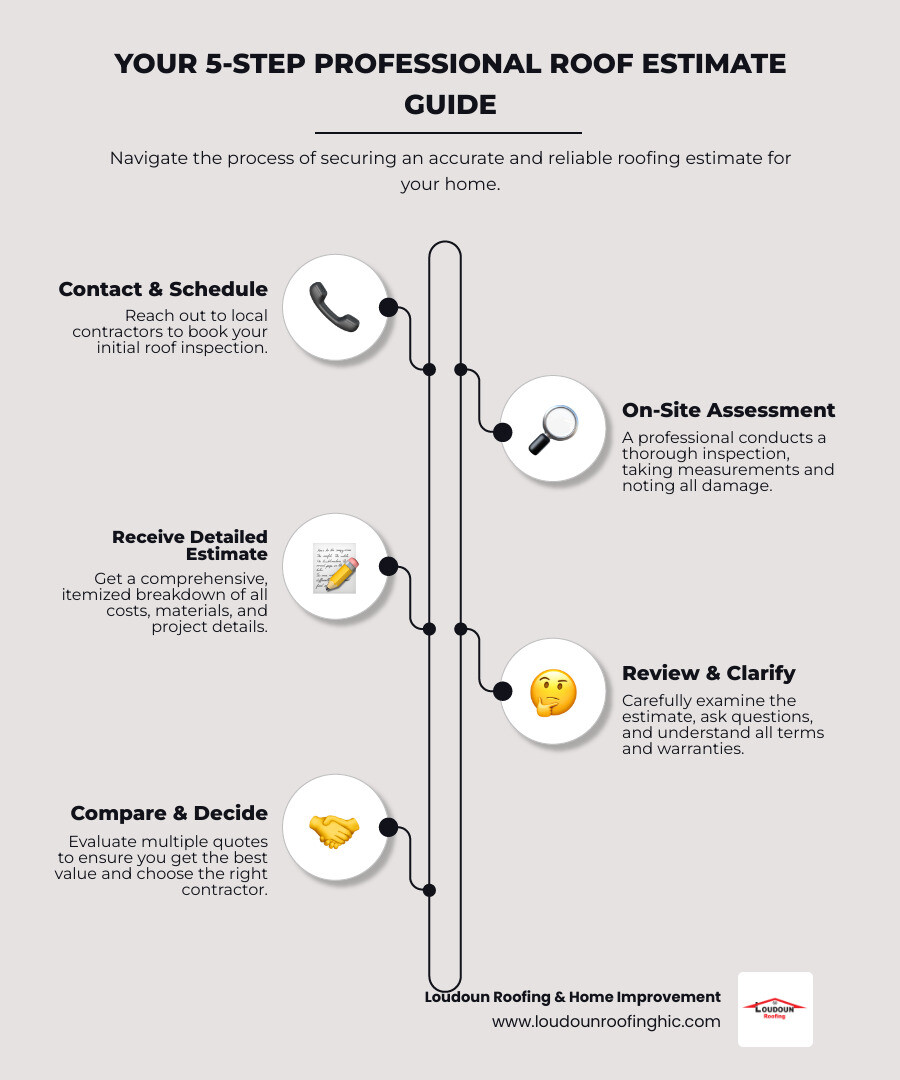
Key terms for free roof estimate:
Understanding What a Comprehensive Roof Estimate Includes
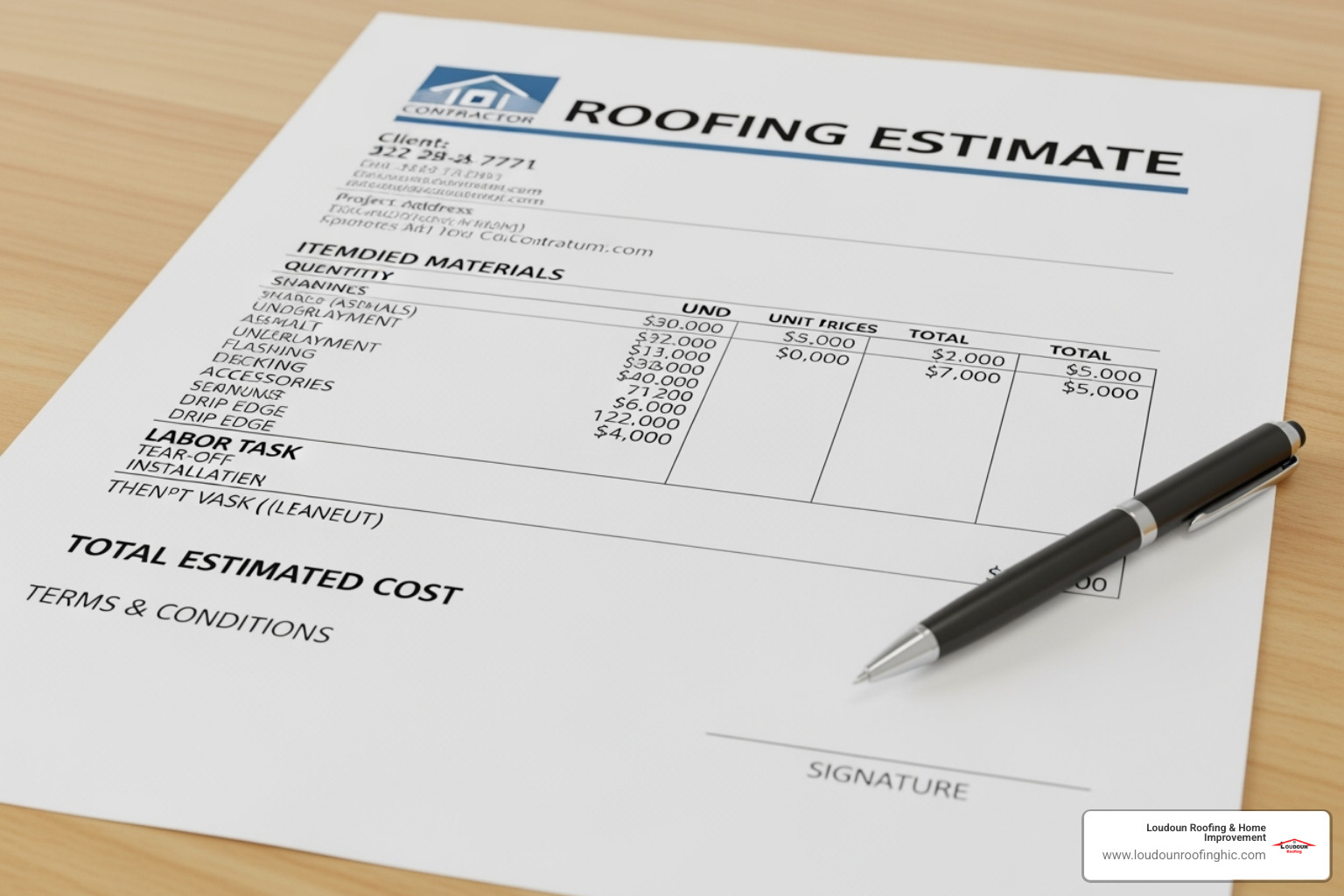
When you’re facing a roofing project, you deserve more than a rough number scribbled on the back of a business card. A comprehensive free roof estimate is your roadmap to understanding exactly what you’re investing in – and it’s the foundation of trust between you and your roofing contractor.
Think of a detailed estimate as your project blueprint. It breaks down every aspect of the work, from the detailed breakdown of costs to the specific materials that will protect your home for decades. When you receive a thorough estimate for your roof replacement project, you should see clear labor costs that account for your roof’s pitch and complexity, material costs that specify exactly which shingles or metal panels will be used, and even permit fees required by your local building department.
Don’t overlook the seemingly small details either. Debris removal costs ensure your property stays clean throughout the project – because nobody wants a yard full of old shingles for weeks. Warranty information should clearly outline both manufacturer guarantees and workmanship warranties, giving you peace of mind long after the last nail is driven. A realistic project timeline helps you plan your life around the work, whether that means arranging for pets to stay elsewhere or coordinating with your home security system.
The difference between a quick quote and a thorough, itemized estimate can save you thousands of dollars and countless headaches down the road.
Roof Repair vs. Roof Replacement Estimates
Here’s where many homeowners get confused – and rightfully so. The scope of work between repairs and replacements is dramatically different, which creates a significant cost difference that can catch you off guard if you’re not prepared.
A repair estimate tackles specific problem areas. Maybe you’ve noticed a few missing shingles after last week’s storm, or there’s a small leak in your kitchen ceiling. Repair estimates focus on these targeted issues, often requiring careful material matching to blend seamlessly with your existing roof. If you’ve experienced storm hail damage that’s localized to one section, a repair estimate will detail exactly what’s needed to restore that area.
Replacement estimates tell a completely different story. They cover your entire roof system from tear-off to final cleanup. This means removing everything down to the roof deck, inspecting for underlying damage, and installing a completely new roofing system. It’s comprehensive work that addresses not just what you can see, but potential problems hiding beneath the surface.
What to Look For in Your Estimate
A professional estimate from a knowledgeable and patient contractor leaves no room for surprises, but you need to know what to look for. Itemized costs should break down every component – you shouldn’t see vague line items like “roofing materials” but specific details about shingle types, quantities, and individual pricing.
The payment schedule matters more than you might think. Reputable contractors don’t ask for large upfront payments, and the schedule should align with project milestones. Proof of insurance and licensing information protect you from liability if something goes wrong – never skip this step, even if the contractor seems trustworthy.
Technical details like underlayment type might seem boring, but this moisture barrier is critical for your roof’s performance. Flashing details around chimneys, skylights, and valleys prevent the most common sources of leaks. Ventilation specifications affect both your roof’s lifespan and your energy bills – proper airflow keeps your attic cooler in summer and prevents ice dams in winter.
When an estimate covers all these bases clearly and completely, you know you’re working with a contractor who understands that your roof is more than just shingles – it’s the shield that protects everything you value most.
Key Factors That Influence Your Roofing Cost
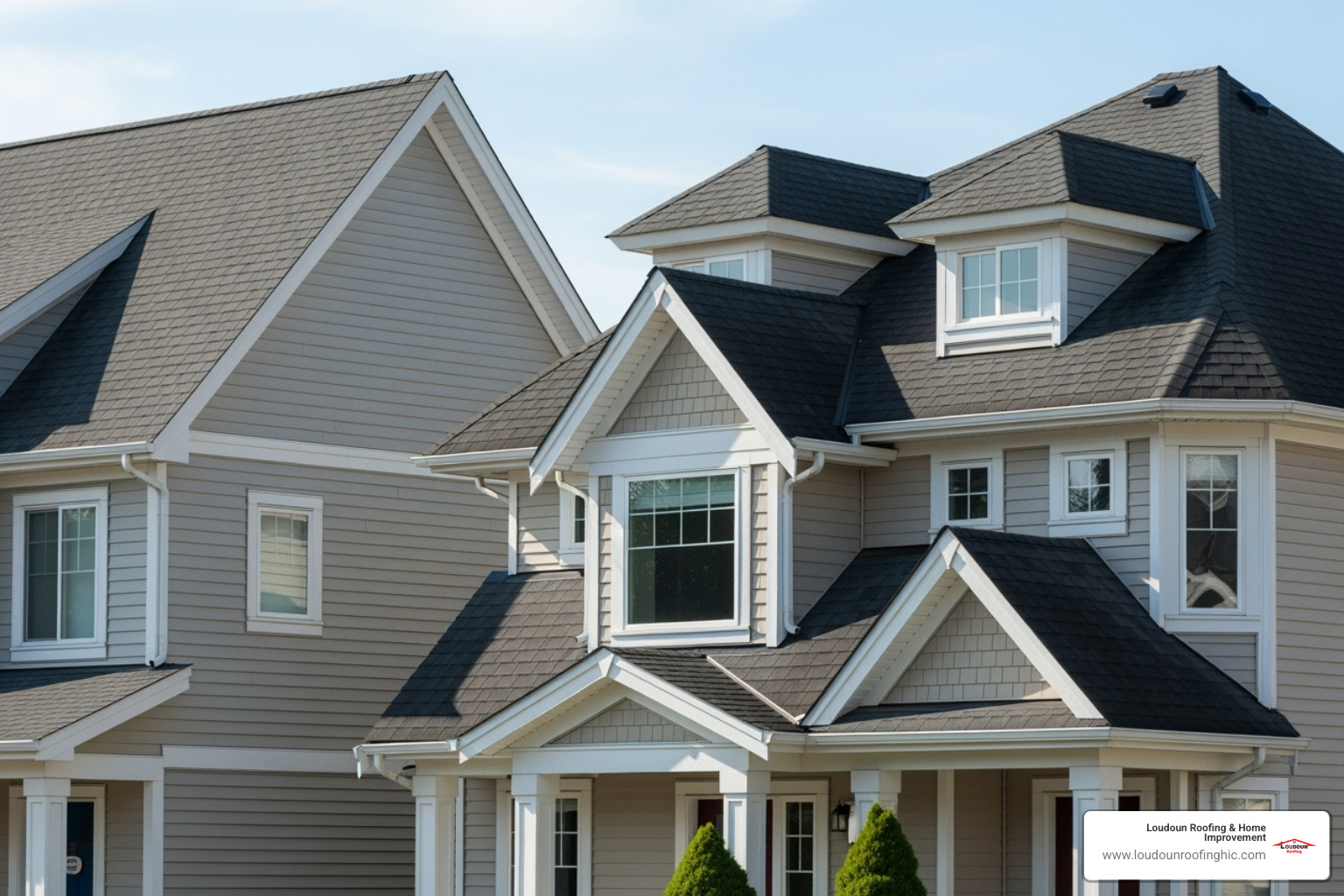
When I prepare a free roof estimate for homeowners, I’m always asked the same question: “Why do roofing costs vary so much from house to house?” The answer lies in understanding the unique factors that make every roofing project different.
Roof size is the most straightforward factor – more square footage means more materials and more labor hours. But that’s just the beginning. Roof pitch plays a huge role in cost because steeper roofs require specialized safety equipment and take longer to work on safely. A 12/12 pitch roof (that’s pretty steep!) costs significantly more than a gentle 4/12 slope.
Then there’s roof complexity, which can really impact your budget. A simple ranch-style home with a basic gable roof is much more affordable than a Victorian with multiple dormers, valleys, and architectural details. Every angle, every interruption, every skylight adds time and materials to the project.
Your material choice will be the biggest variable in your final cost, followed by labor rates that reflect our region’s skilled workforce standards. Seasonal timing can also affect pricing – scheduling during our busy spring season might cost more than a winter installation.
Perhaps most importantly, underlying damage finded during the project can change everything. Water damage, rotted decking, or structural issues need addressing before we can install your beautiful new roof.
Choosing the Right Roofing Material
Your material choice is the biggest variable in the final cost of your residential roofing project. I always tell homeowners that the “best” material is the one that fits their budget, matches their home’s style, and meets their longevity expectations.
Asphalt shingles remain the most popular choice for good reason – they’re cost-effective, come in dozens of colors and styles, and typically last 20-30 years. They’re perfect for most Northern Virginia homes and offer excellent value.
Metal roofing costs significantly more upfront but can last 50+ years with minimal maintenance. It’s incredibly energy-efficient, reflecting heat in summer and shedding snow beautifully in winter. Many of my customers love the modern look and the fact that it might be the last roof they ever need to buy.
Tile roofing offers best durability and a distinctive Mediterranean or Southwestern aesthetic. It’s the most expensive option initially, but tiles can last 75-100 years. The main consideration is weight – your home’s structure needs to handle the extra load.
Each material also performs differently in our Virginia climate. Metal handles our occasional ice storms wonderfully, while quality architectural shingles stand up well to our summer heat and humidity.
How Roof Pitch and Complexity Affect Price
When I’m up on your roof taking measurements for your free roof estimate, I’m not just calculating square footage – I’m assessing how challenging your roof will be to work on safely and efficiently.
Roof pitch directly impacts safety requirements and installation speed. A low-slope roof (4/12 pitch or less) allows my crew to move around easily and work efficiently. But as we get into steeper territory – 8/12, 10/12, or higher – everything changes. We need more safety equipment, work proceeds more slowly, and material handling becomes more complex.
Intricate designs with multiple roof planes, valleys, and hips require more precise cutting and fitting. Each valley needs special waterproofing attention. Skylights and chimneys interrupt the roof’s flow, requiring custom flashing and careful integration with the roofing system.
Dormers are particularly complex because they create multiple angles and transitions. A simple ranch home might take two days to roof, while a Victorian with multiple dormers and complex geometry could take a week or more.
All these factors combine to create your project’s unique cost profile. That’s why a professional inspection is so important – I can spot complexity that might not be obvious from the ground and give you an accurate, detailed estimate that accounts for your roof’s specific challenges.


